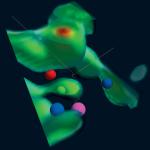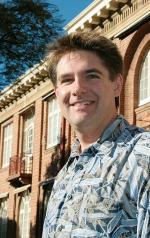Strange particles a quark of nature
 Physics Physics
One of the smallest and most mysterious things known to humans, the "strange quark", isn't as strange anymore, thanks to the University of Adelaide's Associate Professor Derek Leinweber. Dr Leinweber is the leader of an international team of physicists that, with the aid of a supercomputer, has made a major finding into the properties of the strange quark. The theoretical finding - that a strange quark makes a small but essential contribution to the overall magnetism of a host proton - is set to have a big impact on the world of subatomic physics. The team's findings have recently been published in the prestigious international journal Physical Review Letters. Experimental laboratories across the world will now move to test and confirm this precise theoretical prediction; and on a more fundamental level, it has changed scientists' thinking of how subatomic particles - literally the building blocks of everything in the entire universe - compose the world around us. "It is a really important discovery and one that further highlights Adelaide as a place where world-class physics research is being carried out," Dr Leinweber, who is Deputy Director of the Special Research Centre for the Subatomic Structure of Matter based at the University of Adelaide, said. "By exploiting the symmetries of nature and bringing together significant breakthroughs in relating supercomputer simulations to nature itself, we have been able to precisely determine the strange quark's magnetism in a proton."
The strange quark is regarded as one of the most mysterious of the many particles which form protons and neutrons, the two main components of the nucleus of atoms. There are up to six different types of quarks in protons and neutrons: the up, down, top, bottom, charm and strange quark. But the strange quark is expected to play a particularly interesting role. Dr Leinweber's group is determining the contribution each quark makes to the strength of a proton's magnetism (known as its "magnetic moment") and how they are distributed within a proton. For the strange quark, they found that it has a very small but essential influence on a proton's magnetism. "There have been claims that the strange quark contributes up to 20% of the mass of the proton, and carries 10% of the total spin," Dr Leinweber says. "What we found is that for the magnetic moment, the strange quark contributes only half of one percent of the total magnetism of the proton. At the same time, we cannot describe the proton's structure without it! It's a very small value and it will give physicists all over the world the opportunity to reconsider the structure of the proton and the strange quark's place within it." Such discoveries are based on a complex mathematical theory called Quantum Chromodynamics (QCD). They rely extensively on enormous computing power in order to accurately calculate the theory. Dr Leinweber's group used the Australian Partnership for Advanced Computing supercomputer based at the Australian National University in Canberra. "The APAC supercomputer had a top speed of five teraflops, or five trillion calculations per second," he said. "It's the sort of performance you just can't replicate on even many hundreds of PCs. "To resolve the properties of the strange quark, we had the supercomputer perform about
10,000,000,000,000,000,000 calculations, or 1019. By comparison, the age of the universe is roughly 1017 seconds." "Another way to look at it is that if you had 400,000 PCs doing nothing else, it would take you one day to perform that many calculations - or if you had 1000 PCs doing nothing else, one year. The fast network connections within supercomputers are crucial to crunching these vast amounts of numbers in a timely way." Story by Ben Osborne
|






